
Historic buildings
Before I start with this page, I would like to point out that this is only one small area of Antarctica and there is so much more to see out there. The huts Im about to show you where built by explorers like Scott and Shackelton. The huts, once built, where used by anyone who needed their shelter, and to this extent they have been the home of great explorer's, sightseers and adventurer's alike. These huts have survived in some of the worlds worst weather, but they may not survive the tourists who visit. The constant wear and tear caused by so many visitors is literally wearing the huts out. The effects are small but compounding and those who look after the huts have noticed the changes. There was talk of making the huts available to the public by transporting them from Antarctica back to another country (possible New Zealand). My personal view is that if you are truly interested in Antarctica then you will make the pilgrimage on one of the ships that do the tours.

One of Scott's two Antarctic huts and often referred to as Discovery hut. It is located at Hut Point just outside McMurdo (an American base) on the entrance to backwater bay. Many Antarctic trips where started from this hut and it has withstood the test of time and nature beyond many peoples expectations. People often forget the significance of this small building because it is so assessable to residents of the island. The Antarctic historic society have put alot of time and effort into restoring the building to its original condition. This meant clearing out all the snow and ice after it was abandoned for many years and replacing much of the damaged woodwork. A story is told that when they dug out the ice and snow they found tins full of biscuits and canned food in the building and yet reports from dairies of the last expeditions that used the building stated how they had just about run out of food. It was surmised that the food which was found was from a previous expedition and the following expedition did not shovel out enough snow and ice to find it.
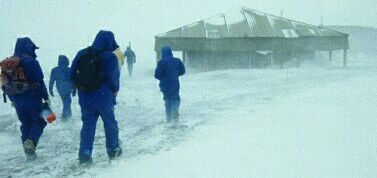
Within a day of getting to Antarctica in October 1997 we visited the Historic Hut at Hut point and then continued on with our Antarctic survival training, which happened to be detecting and understanding sea ice cracks not far away.
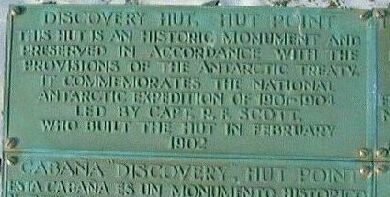
Most huts and historic sites in this area of Antarctica have a plaque which describes what they are with some basic details. They are written in 4 languages (one of them being english, thankfully).
Below... Cape Evan's, another one of Scott's Huts. There seems to be something about both of Scott's huts that gives you the feeling of a tough life, made tougher by the attitude of the leader. Its a feeling you get when you compare the inside of these buildings compared to Shackeltons hut at Cape Royds (later in the page). Take note of the side of the building. What seems like an extra shed built onto the side is actually accommodation for the Ponies which where to be used for exploration. Scott seemed to have a thing against dogs because he never put his faith in them like many other explorers did. Unlike Armensdon (who used his dogs alot) Scott preferred to use machines. He detested the idea of killing and eating his dogs (in the worst possible situations) so that he could survive. This was not a problem to other explorers......
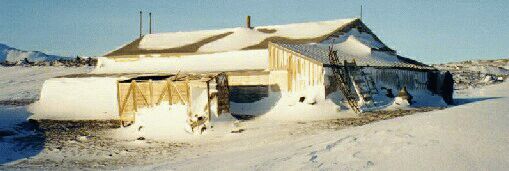
As you can see, these are the stalls for the ponies. They where meant to be some sort of pony which could handle the cold. But alas it was not meant to be. I understand they had some difficulty with getting the ponies of the ship. You may have read that Orcas (Killer Whales) don't attack humans but that doesn't say they don't like horse flesh and they apparently did their damnedest to break through the ice and get to the horses. They apparently terrified the horses as they where being unloaded of the ship and a few where taken or injured by the Orcas. (Or so the story goes !!)
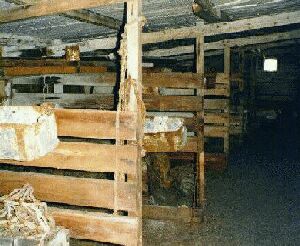
I know the photo is not of a high quality definition but you get the idea of bleak and very dull living conditions. There would have one been a time when these walls where packed with around 19 young adventurous men. Many of them where from backgrounds as simple as farming who where looking for a way to prove themselves and taste a little adventure. Ill bet that none of them could have imagined what life would be like on the frozen continent. Without the comforts of modern technology which tames the wildness of Antarctica these men saw mother natures worst atrocities .... many of them living to tell the tale.

What you see in the photo below is the front porch area. To the left you see the doorway to the stables and if you where to go right you would go into the doorway of the main building. Many of the early adventurers quickly learnt the benefits of a double doorway entrance to protect themselves from the weather outside. It meant you didn't have to let all the heat out (or the cold in ) whenever someone went outside. The pile of stuff in the bottom picture is seal meat. Harvested and cut into strips and stored. The seal meat could be eaten (though it was very fatty) but more essential was its ability to be burnt for fuel. The problem was the amount of black fatty deposits the smoke left behind. That's what makes the inside of Scott's huts look so black and foreboding. The dogs also loved seal meat (as all Antarctic dogs would for years to come) the high fat and nutrient content was virtually all a dog needed to keep in good condition. Just think ...( I think Im correct in saying) .... This seal meat is almost a 90 years old !!
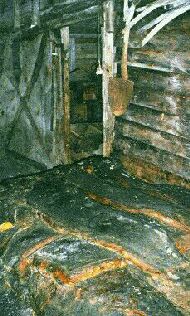
One of the many oddities is the emperor penguin still sitting on Scott's desk (I say Scott's desk but Shackeltons crew where the last great explorers to use the hut). I think that every visitor to the historic huts sees this penguin and takes a photo. From memory the people in the hut left in a hurry and much of their equipment was left behind ... including any research they where doing at the time. However their is a bit of confusion over the origin of the Emperor penguin and many believe it is a practical joke put there by some previous visitor in the early days.

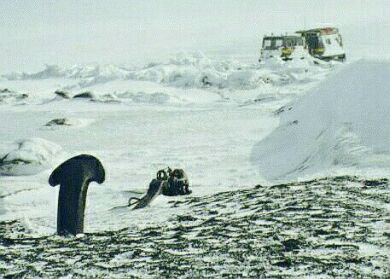
Have a look at where our Hagglunds is parked and then look at the anchor from the Ship "Aurora". Our Hagglunds is where they parked their boat (approximately). At some point the boat got separated from the anchor which caused a bit of concern for those still on land, from what I understand. It was Shackeltons crew who where left on land one stormy day on the 6th of May 1915. The boat was blown out into pack ice and trapped for many months. The crew on land had to spend a winter they didn't expect, locked up in Scott's hut. They tell me there is another anchor just off shore which very few people ever see because of access to the location when the sea ice melts.

Above and below we see Shackeltons Hut at Cape Royds, tucked into a small natural hollow shelter. This site was most likely chosen for its sheltered position but maybe also because it is right on the boundary of a penguin rockery. The small Adelie penguin with its Charlie Chaplin like characteristics returns here year after year to breed (among other places) and rear its young. If you look at the bottom picture and onto the hill across the other side of the small lake you will see the main area where they roost (if you can call lying down and acting like a rock while being covered in snow during freezing Antarctic gale roosting....). The area is what they call a "triple S, I" area ... I don't remember the exact words but it means "Scientific study area KEEP OFF" and it is marked by signs etc etc ....
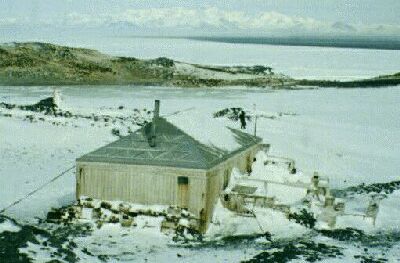
The first thing you notice when you go into Shackeltons hut is the Open Plan Living and sleeping arrangements. No segregation, like in Scott's huts, you get the feeling that everyone is equal. You will also notice that there are dog kennels outside which Shackelton used extensively. You may have noticed that there is light in the building. That comes through the glass windows that are normally boarded over to stop the antarctic weather from smashing them in.
To get into any of the huts you need a few things. Keys... Without keys you obviously don't have permission. The antarctic historic society (along with many others) has put alot of work into restoring the huts to their original condition, so they don't want uninvited tourists ransacking the place for trophies to remember their visit. The keys for access can be picked up from Scott Base or McMurdo station. There are also certain rules to abide by. No more than eight people in the hut at any one time and the place must always be swept out before locking up again. There are always the obvious rules like no fires, smoking etc while inside the huts.
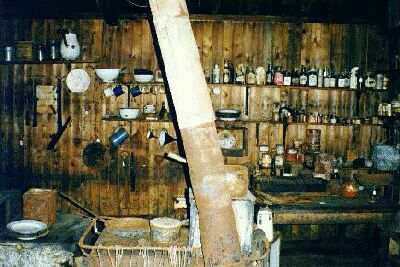
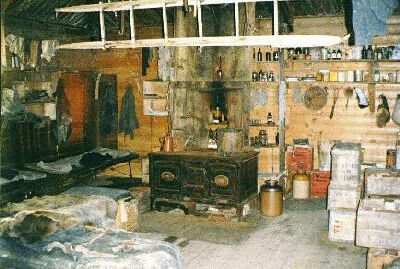
www.geocities.com/coolrunnernz/
9-3-01